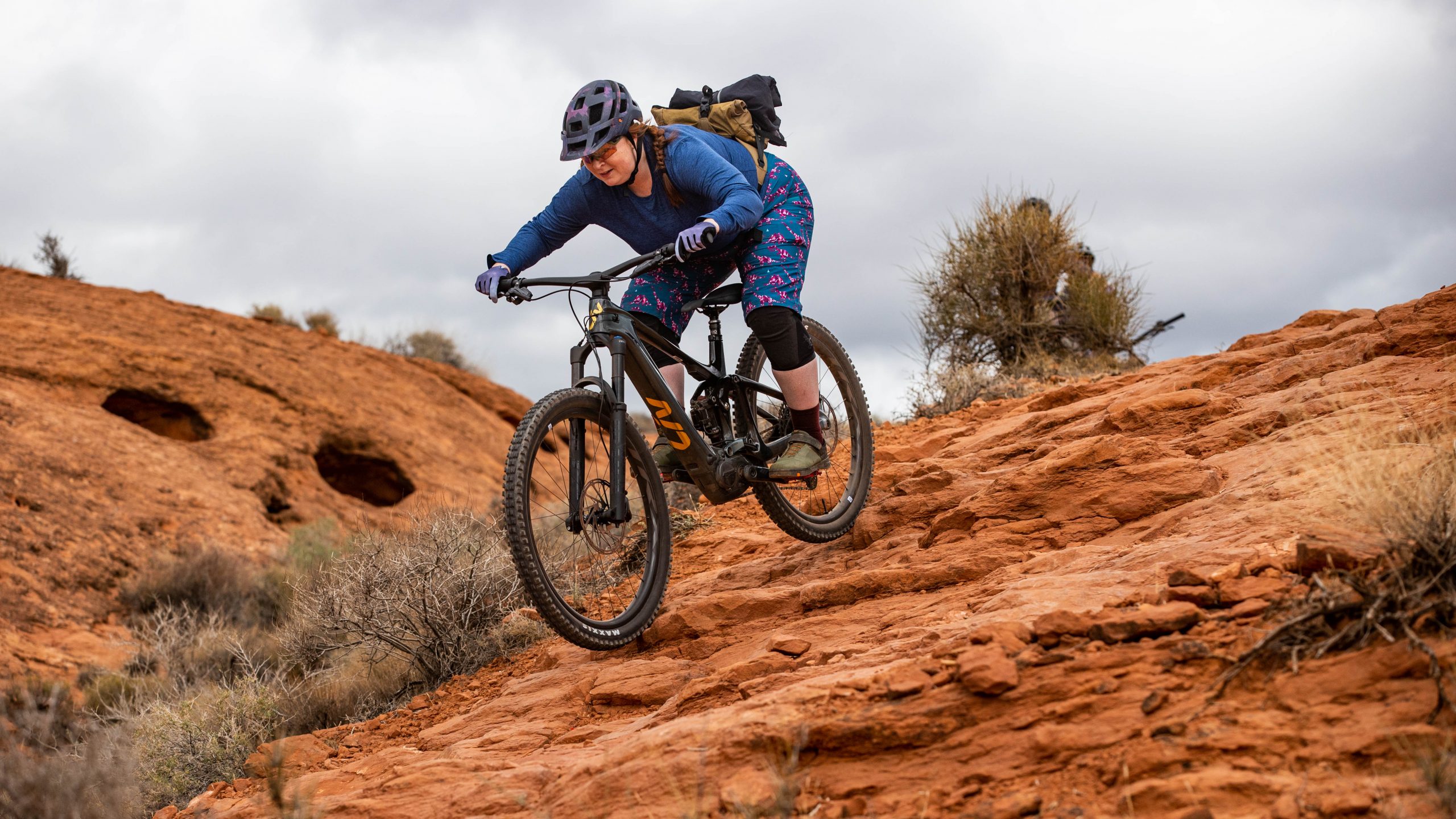New to e-bikes? Dazzled by jargon like drive unit and display? Not really sure what the difference is between a full-powered and SL e-bike, or what that means for you as a rider? Don't worry, this will get you up to speed
Bike anatomy can be jargon-riddled as it is, then you add electricity to the mix and it gets a whole lot more complicated. Drive units, displays, sensors, full-fat and diet – what does it all mean?! To demystify it all, we’ve broken down some of the most common elements of the average e-bike, plus provided a little extra advice to help you work out exactly what type of eMTB is right for you.
Once you’ve got the jargon sorted, you’ll be able to more easily read through our buyer’s guide to the best electric mountain bikes, where we’ve collated only the very highest scoring bikes from our extensive testing process. There are bikes in there to suit every type of riding and plenty of budgets. Or if you want to skip straight to the cheap eMTBs that offer great performance for a lower price point, our budget electric mountain bike guide is where to head.

Anatomy of the main elements of an electric mountain bike
1. Drive unit
The motor on all good electric mountain bikes is mid-mounted, that’s to say it drives the bottom bracket axle and the chainring, rather than being mounted in the rear hub and powering the wheel. The advantage of this is a lighter rear wheel, which means better suspension performance and more dynamic handling as the weight is more centered on the bike.
There are various different motors on the market, but almost all of them transfer power from the motor to the chainring through a system of cogs. Peak power can range from 300-600w depending on the system, and peak torque is typically between 50-90Nm. Drive units are fully sealed in an aluminium or magnesium case.
2. Battery
Modern e-bikes hide their lithium-ion batteries inside the down tube to give the frame a sleek look. Most full power e-bikes have removable batteries using either a hatch cut into the frame, or a hole at the base of the down tube that the battery can slide out of. The latter design keeps the integrity of the tube, so the frame needs less reinforcement, and can benefit weight balance if done properly, but is slightly less convenient.

Batteries can fit in different ways, slotting in from underneath or sometimes coming with a lockable cover.
Full power e-bikes on average use a 700Wh battery, although it’s possible to get e-bikes with 900Wh options. The bigger the battery the heavier the weight, but the longer the range. Diet e-bikes, such as the Pivot Shuttle SL, use smaller batteries to save weight, bolstered by range extenders shaped like water bottles.
3. Display
Most e-bikes have some sort of display, to indicate the power mode selected and the battery life remaining. Some even have screens showing speed, cadence, power output and a host of other features. Recently brands have been starting to integrate their displays into the top tube, saving space, adding protection and making them easy to read. Most systems hook up to a smartphone app giving you the ability to change the response of the motor and the amount of power in each mode.

The control unit on this Liv eMTB is so discrete you might almost miss it! It’s the part that sits between the grips and the brake and gear shift mounts.
4. Controller
To change between power modes, most e-bikes fit a remote on the handlebars. For mountain biking, the smaller the better, so as not to interfere with dropper post levers. A typical control unit will have a + and – button for changing modes, a power button for turning on and off, and a walk button, that powers the motor slowly if you have to get off and push the bike up a hill.
5. Magnet and speed sensor
E-bikes have a suite of sensors, most of which are hidden within the motor unit, but the main external one is the speed sensor. This monitors the wheel speed and also tells the motor when to cut out – 25km/h in Europe. Older e-bikes used a magnet clamped to a spoke, but newer models have a more discreet magnet attached to the rear disc rotor, along with a sensor hidden in the dropout. Bosch goes one better on its latest systems with a magnet that attaches to the presta valve on the back wheel, monitored by a sensor in the back of the motor. This gets rid of the wiring between the motor and the dropout.

Many brands are bringing out cranks specifically designed for the rigours of e-bike use, like these from Cane Creek
6. Cranks
E-bikes separate the crank and the chainring, as the chainring can continue to rotate even when you stop pedalling. Chainrings are typically a bit bigger than on an analogue bike (often 34t instead of 30t or 32t) and cranks usually shorter. You’ll generally find 165mm cranks on an e-bike since the motor means you’re less reliant on the torque of your legs. Shorter cranks improve ground clearance, which is useful because you pedal more on an e-bike.
E-bike FAQ

Which e-bike is right for you?
As e-bikes have become more popular, the breadth of e-bike options has spread. There are now hardtail, XC, trail, enduro and bike park-focussed e-bikes on the market, with both lightweight motors and small batteries and full power motors and large capacity power packs. So which is right for you?
Should I go for a full-power or low-power, low weight eMTB?
The muscle cars of the e-bike world are the full fat models, fitted with motors that produce around 600 watts of power at their peak, and crank out around 90Nm of torque. Examples of these motors include the Bosch Performance Line CX, Shinano EP801, and Specialized’s Brose-built 2.2 motor. Supplying power will be a large capacity battery between 600 and 900wh and the total system weight will be around 7-8kg. This translates into an average complete bike weight between 20kg and 25kg.

Diet e-bike systems, on the other hand, are the lightweight race cars. They deliver about half the power (300W) and half the battery capacity (360Wh), but weigh half as much (4kg for battery and motor). Complete bikes are in the 16-19kg weight range. The most popular motors are the TQ HPR 50, Fazua Ride 60, Bafang, and the Specialized/Mahle 1.1 system.
Full fat models make sense if you want to let the motor take the strain. You can soft pedal up a climb if you’re tired, or use the extra torque to challenge your hillclimb skills. They’re more stable but require more muscle to hustle around, and the more powerful motor makes mincemeat of muddy trails, so they’re still loads of fun in the winter.
Diet e-bikes offer a much closer riding experience to an analogue bike, so you can ride dynamically with less effort, and the reduced motor resistance means you can pedal them above the speed limit when the motor cuts out. This makes them more enjoyable on shallow gradients and flat singletrack, and can make them more fun for smaller riders who may not have the physical strength to chuck a full-fat e-bike around.
On the other hand, you have to dial down the power to maximise the range, so you’ll need to be fit to keep up with a mate on a full-fat e-bike.
If you’re interested in learning more about the different e-bike motor systems and their pros and cons, check out our guide to the best electric mountain bike motors. We’ve put them all through their paces on a variety of terrain to see how they perform.

Trek Fuel EXe – a lightweight eMTB
XC, trail or enduro electric mountain bike – which is best?
One thing that’s obvious about e-bikes from the first ride is that travel is much less important when it comes to intended use compared to an analogue bike. Most e-bikes in the 140-160mm travel range can be ridden as hard as an enduro bike thanks to the stability created by the battery and motor. With sturdy tyres and a sturdy fork, they soak up abuse like a punchbag. On the other hand, most diet e-bikes struggle to replicate the speed and efficiency of an XC race bike on smooth, flowing singletrack.
What we’re trying to say is, unless you spend 90% of your time in a bike park, hitting moto-sized jumps, an e-bike with 140-160mm of travel will cover most bases.

The Canyon Torque:ON CF9 – proof that anything a regular bike can do, an e-bike can do too
Hardtail or full-suspension electric mountain bike?
If you’re riding consists solely of tow paths, fire roads and country tracks, then e-hardtails can make a lot of sense, since they are generally cheaper and there’s less to go wrong. But for hitting proper singletrack, bike parks and trail centres, we wouldn’t recommend one.
The reasons are simple. You remain seated far more on an e-bike than an analogue bike – mostly because the motor prefers a high cadence, and the up-down piston motion of your legs when standing up doesn’t mesh well with the smooth, consistent power delivery of the motor. So without any rear suspension you’re in for a punishing ride on anything but billiard-table smooth trails.
E-bikes let you ride up climbs you wouldn’t dream of on a regular bike, but if you can’t get traction – because the rear wheel is bouncing over bumps and roots – you’ll be off and pushing.
Finally, on fast, rough or technical descents, it’s much harder to get an e-bike off the ground, so rear suspension not only helps reduce the impacts at the rim, it also helps you pop the bike over square-edge hits. Which is why most e-hardtails we’ve seen on technical trails are being pushed – with a flat back tyre.
Feeling up to speed? Head on over to check out our guide to the best electric mountain bikes and best budget electric mountain bikes out there. And while they are rarer than unisex e-bikes, there are also a selection of the best women’s electric mountain bikes.




